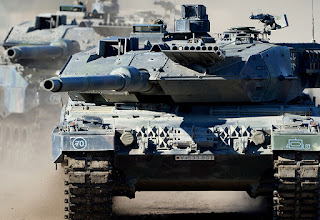Tanks Military
 There are two main development batches of the tank, the original models up to Leopard 2A4, which have vertically faced turret armour, and the "improved" batch, namely the Leopard 2A5 and newer versions, which have angled arrow-shaped turret appliqué armour together with other improvements. All models feature digital fire control systems with laser rangefinders, a fully stabilized main gun and coaxial machine gun, and advanced night vision and sighting equipment (first vehicles used a low-light level TV system or LLLTV; thermal imaging was introduced later on). The tank has the ability to engage moving targets while moving over rough terrain.
There are two main development batches of the tank, the original models up to Leopard 2A4, which have vertically faced turret armour, and the "improved" batch, namely the Leopard 2A5 and newer versions, which have angled arrow-shaped turret appliqué armour together with other improvements. All models feature digital fire control systems with laser rangefinders, a fully stabilized main gun and coaxial machine gun, and advanced night vision and sighting equipment (first vehicles used a low-light level TV system or LLLTV; thermal imaging was introduced later on). The tank has the ability to engage moving targets while moving over rough terrain.
Even as the Leopard 1 was just entering service, the German military was interested in producing an improved tank in the next decade. This resulted in the start of the MBT-70 development in cooperation with the United States beginning in 1963. However already in 1967 it became questionable whether the MBT-70 would enter service at any time in the foreseeable future. Therefore, the German government issued the order to research future upgrade options of the Leopard 1 to the German company Porsche in 1967. This study was named vergoldeter Leopard (Gilded Leopard) and focused on incorporating advanced technology into the Leopard design. The projected upgrades added an autoloader, a coaxial autocannon and an independent commander's periscope. The anti-air machine gun could be operated from inside the vehicle and a TV surveillance camera was mounted on an expendable mast. The shape of the turret and hull was optimized using cast steel armour, while the suspension, transmission and the engine exhaust vents were improved.
The Leopard 2 is a main battle tank developed by Krauss-Maffei in the 1970s for the West German Army. The tank first entered service in 1979 and succeeded the earlier Leopard 1 as the main battle tank of the German Army. Various versions have served in the armed forces of Germany and 12 other European countries, as well as several non-European nations. The Leopard 2 was used in Kosovo with the German Army and has also seen action in Afghanistan with the Danish and Canadian contributions to the International Security Assistance Force, as well as seeing action in Syria with the Turkish Armed Forces against IS and the YPJ.
 There are two main development batches of the tank, the original models up to Leopard 2A4, which have vertically faced turret armour, and the "improved" batch, namely the Leopard 2A5 and newer versions, which have angled arrow-shaped turret appliqué armour together with other improvements. All models feature digital fire control systems with laser rangefinders, a fully stabilized main gun and coaxial machine gun, and advanced night vision and sighting equipment (first vehicles used a low-light level TV system or LLLTV; thermal imaging was introduced later on). The tank has the ability to engage moving targets while moving over rough terrain.
There are two main development batches of the tank, the original models up to Leopard 2A4, which have vertically faced turret armour, and the "improved" batch, namely the Leopard 2A5 and newer versions, which have angled arrow-shaped turret appliqué armour together with other improvements. All models feature digital fire control systems with laser rangefinders, a fully stabilized main gun and coaxial machine gun, and advanced night vision and sighting equipment (first vehicles used a low-light level TV system or LLLTV; thermal imaging was introduced later on). The tank has the ability to engage moving targets while moving over rough terrain.Following the end of the Gilded Leopard study in 1967, the West-German government decided to focus on the Experimentalentwicklung (experimental development) in a feasibility study and to develop new components for upgrading the Leopard 1 and for use on a future main battle tank programme. At first 25 million DM were invested, but after the industry came to the conclusion that with such a low budget the development of the two projected testbeds was not possible, a total of 30 to 32 million DM was invested. More details
